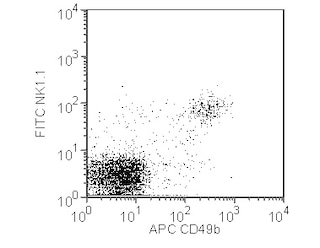-
Your selected country is
Middle East / Africa
- Change country/language
Old Browser
This page has been recently translated and is available in French now.
Looks like you're visiting us from {countryName}.
Would you like to stay on the current country site or be switched to your country?




Multicolor flow cytometric analysis of CD314/NKG2D expression on mouse splenocytes. BALB/c splenic leucocytes were stained with APC Rat Anti-Mouse CD49b (Cat. No. 560628) and either BD Horizon™ BV421 Rat IgG1 isotype control (Cat. No. 562868, Left Panel) or BD Horizon™ BV421 Rat Anti-Mouse CD314 antibody (Cat. No. 562800, Right Panel), in the presence of Purified Rat Anti-Mouse CD16/CD32 antibody (Mouse BD Fc Block™; Cat. No. 553141/553142). Two-color flow cytometric dot plots showing CD314 (or Ig isotype control staining) versus CD49b expression were derived from gated events with the forward and side light-scatter characteristics of viable splenic leukocytes. Flow cytometry was performed on a BD™ LSR II Flow Cytometer System.


BD Horizon™ BV421 Rat Anti-Mouse CD314

Regulatory Status Legend
Any use of products other than the permitted use without the express written authorization of Becton, Dickinson and Company is strictly prohibited.
Preparation And Storage
Product Notices
- Since applications vary, each investigator should titrate the reagent to obtain optimal results.
- Source of all serum proteins is from USDA inspected abattoirs located in the United States.
- An isotype control should be used at the same concentration as the antibody of interest.
- Please refer to www.bdbiosciences.com/us/s/resources for technical protocols.
- Caution: Sodium azide yields highly toxic hydrazoic acid under acidic conditions. Dilute azide compounds in running water before discarding to avoid accumulation of potentially explosive deposits in plumbing.
- For fluorochrome spectra and suitable instrument settings, please refer to our Multicolor Flow Cytometry web page at www.bdbiosciences.com/colors.
- Pacific Blue™ is a trademark of Molecular Probes, Inc., Eugene, OR.
- Brilliant Violet™ 421 is a trademark of Sirigen.
Companion Products






The CX5 monoclonal antibody specifically binds to NKG2D, also known as CD314. NKG2D is a lectin-like receptor that is detected on resting and IL-2-activated NK cells, activated CD8-positive T lymphocytes, and LPS-activated macrophages, but not on resting T cells or unstimulated macrophages. NKG2D has little homology to the other members of the NKG2 family, NKG2A, C, and E, and does not form heterodimers with CD94. On NK cells, NKG2D is an activating receptor that associates with DAP10, an adapter protein that stimulates the PI3 kinase pathway. An isoform of mouse NKG2D can also associate with the signaling adapter protein DAP12, also known as KARAP (Killer cell-Associated Receptor-Associated Polypeptide), that activates the Syk and ZAP70 tyrosine kinases. On cytotoxic T cells, NKG2D is a co-stimulatory receptor that associates with DAP10. The ligands for NKG2D include the minor histocompatibility antigen H60, MULT1 (Murine UL16-binding protein-Like Transcript 1), and the five retinoic acid-inducible proteins Rae-1α, β, γ, δ and ε. Interactions of NKG2D with its ligands are involved in the regulation of innate and immune cytotoxic responses to tumor and pathogen-infected cells and in diabetes progression in the NOD mouse. The CX5 mAb blocks the binding of NKG2D to its ligands.
The antibody was conjugated to BD Horizon™ BV421 which is part of the BD Horizon™ Brilliant Violet™ family of dyes. With an Ex Max of 407-nm and Em Max at 421-nm, BD Horizon™ BV421 can be excited by the violet laser and detected in the standard Pacific Blue™ filter set (eg, 450/50-nm filter). BD Horizon™ BV421 conjugates are very bright, often exhibiting a 10 fold improvement in brightness compared to Pacific Blue™ conjugates.

Development References (8)
-
Carayannopoulos LN, Naidenko OV, Fremont DH, Yokoyama WM. Murine UL16–binding protein–like transcript 1: A newly described transcript encoding a high–affinity ligand for murine NKG2D . J Immunol. 2002; 169(8):4079-4083. (Biology). View Reference
-
Cerwenka A, Bakker AB, McClanahan T, et al. Retinoic acid early inducible genes define a ligand family for the activating NKG2D receptor in mice. Immunity. 2000; 12(6):721-727. (Biology). View Reference
-
Diefenbach A, Jamieson AM, Liu SD, Shastri N, Raulet DH. Ligands for the murine NKG2D receptor: expression by tumor cells and activation of NK cells and macrophages. Nat Immunol. 2000; 1(2):119-126. (Biology). View Reference
-
Diefenbach A, Tomasello E, Lucas M, et al. Selective associations with signaling proteins determine stimulatory versus costimulatory activity of NKG2D. Nat Immunol. 2002; 3(12):1142-1149. (Biology). View Reference
-
Gilfillan S, Ho EL, Cella M, Yokoyama WM, Colonna M. NKG2D recruits two distinct adapters to trigger NK cell activation and costimulation . Nat Immunol. 2002; 3(12):1150-1155. (Biology). View Reference
-
Ogasawara K, Hamerman JA, Ehrlich LR, et al. NKG2D blockade prevents autoimmune diabetes in NOD mice. Immunity. 2004; 20(6):757-767. (Clone-specific: Blocking). View Reference
-
Ogasawara K, Hamerman JA, Hsin H, et al. Impairment of NK cell function by NKG2D modulation in NOD mice. Immunity. 2003; 18(1):41-51. (Immunogen: Blocking). View Reference
-
Yokoyama WM. Natural killer cell receptors. Curr Opin Immunol. 1998; 10(3):298-305. (Biology). View Reference
Please refer to Support Documents for Quality Certificates
Global - Refer to manufacturer's instructions for use and related User Manuals and Technical data sheets before using this products as described
Comparisons, where applicable, are made against older BD Technology, manual methods or are general performance claims. Comparisons are not made against non-BD technologies, unless otherwise noted.
For Research Use Only. Not for use in diagnostic or therapeutic procedures.
Report a Site Issue
This form is intended to help us improve our website experience. For other support, please visit our Contact Us page.